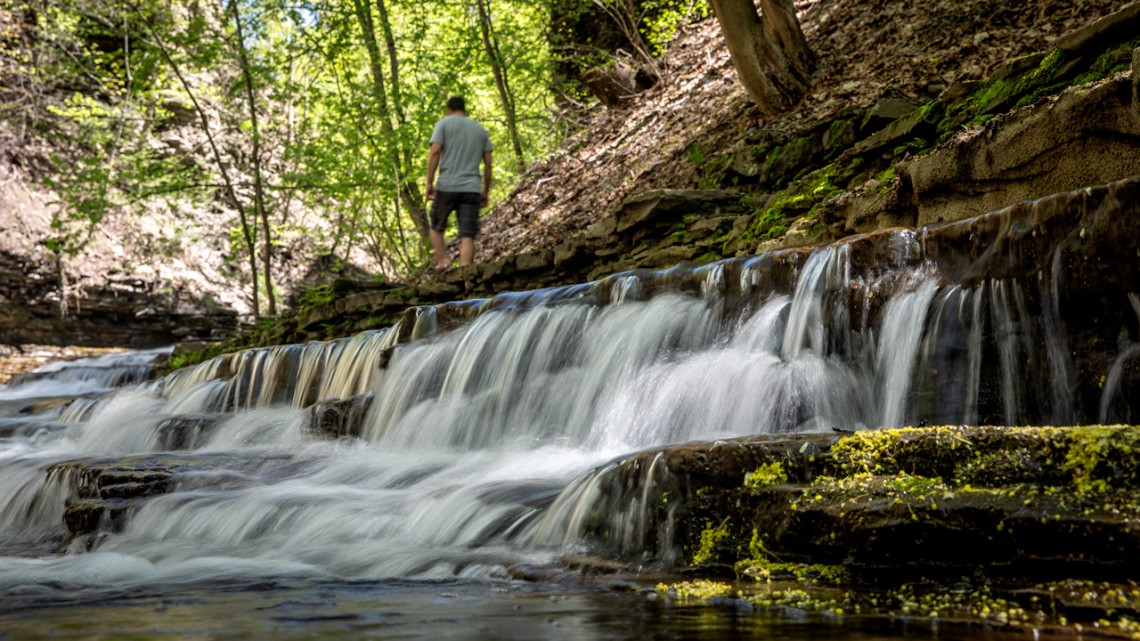
Cornell’s gorge safety website and gorge stewards on campus trails provide education, help and guidance on enjoying gorges and natural areas safely.
Cornell urges safe practices in gorges
By Krishna Ramanujan, Cornell Chronicle
As Ithacans and visitors enjoy Cornell Botanic Gardens’ natural areas and gorge trails, they need to exercise care and follow rules to keep safe in areas that can be deceptively dangerous.
Usage of the Fall Creek and Cascadilla gorge trails is expected to be high this year as Cornell’s summer operations return to pre-pandemic levels. To help keep users safe, the Gorge Stewards Program – in which students, community members and Cornell Outdoor Education (COE) staff patrol the trails – will field its largest-ever cohort of stewards, with 12 in all.
“I believe the steward program has had a positive impact on safety,” said Mark Holton, the Lindseth Co-Director of COE. “In addition to statistics we collect on usage, there have been several occasions where stewards have prevented accidents in the moment.”
In one instance, a steward ushered a group away from a cliff edge just before rocks avalanched down in the exact spot they’d been standing, Holton said. Another time, a steward stopped a swimmer who was about to plunge into a dangerous hydraulic at the base of Horseshoe Falls during high water.
From 2013 – when gorge stewards started collecting statistics on visitors – to 2019, the average percentage of users in violation of rules dropped. By 2019, the number of recorded violations was at nearly zero, which was likely in part due to the installation of gates at Ezra’s Tunnel. In 2020, when the COVID-19 pandemic brought more users to the trails and gorges, the average percentage of users in violation of rules rose to around 7.5%. In 2021, it dropped to 3%, but last year it climbed to 4.2%.
“While we welcome people to come and enjoy the natural areas, we’re not seeing things going in the right direction,” said Todd Bittner, natural areas director for Cornell Botanic Gardens. “We need people to respect the gorge and use it safely.”
Respecting the gorge means understanding that it can be dangerous, and leaving no trace while walking, added Bittner, former chair of the university’s Cornell Gorge Safety Committee. Gary Stewart, associate vice president for community relations, and Kevin Perry, director of the Tatkon Center for New Students, are the current co-chairs.
People have gotten into trouble – at times fatally – by swimming, rock climbing, or venturing off trails, particularly at night – and falling into the gorge.
“Noncompliance is directly related to accidents and fatalities,” Bittner said. “And those accidents also put first responders at risk.”
Gorge stewards serve as ambassadors for the trails, patrolling the paths to assist and educate visitors about the nature, geology and history of these unique areas. They also provide directions, inform people about safe practices and deter dangerous behavior. The program has been managed by COE since 2012.
“I think that knowing the gorges are patrolled discourages dangerous behavior before it happens,” Holton said.
Stewards perform other tasks, as well, providing information and talking to people about safe swimming alternatives, and they are often the face of Cornell Botanic Gardens in the gorge areas it manages, Holton said.
All the gorge safety program’s components advocate basic safety guidelines: Stay on trails or within designated areas; no bicycles on the trails; no swimming; and stay out of closed trails or other restricted areas marked by fences, gates or railings.
Swimming, in particular, is extremely dangerous and can lead to death, and is strictly prohibited in the gorges at all times. The Gorge Safety site can direct people to information on safe outdoor swimming options off campus. Red emergency locator signs have been installed along the gorge trails to help hikers in distress provide their locations to first responders.
Starting the week of June 19, the Cascadilla Gorge Trail will be closed for repairs from the entry on Court Street to the College Avenue bridge, but should reopen the following week. A maintenance crew will be elevating a section of stairs downstream from the College Avenue bridge to mitigate creek water overtopping the trail after heavy rain events.
Such events have become more frequent with climate change: Since the late 1950's, the area has seen more than a 70% increase in rainfall that totals more than 2 inches in a 24-hour period.
Cornell Botanic Gardens offers more than 30 miles of trails; students and visitors can also explore more than 240 miles of trails in Tompkins County.
Media Contact
Get Cornell news delivered right to your inbox.
Subscribe
